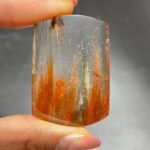Introduction

Jasper, a captivating gemstone renowned for its earthy hues and enigmatic patterns, encompasses a wide array of varieties, each boasting unique characteristics that enthrall collectors and enthusiasts alike. This comprehensive guide delves into the diverse realm of jasper gemstones, exploring their distinct types, properties, and potential applications.
Common Types of Jasper
1. Red Jasper
- Appearance: Rich, opaque crimson to deep burgundy with occasional black or brown inclusions
- Hardness: 7 on the Mohs scale
- Origin: Found worldwide, including India, Africa, and the United States
- Properties: Associated with courage, strength, and grounding
2. Yellow Jasper
- Appearance: Vibrant yellow to mustardy hues with intricate patterns or veining
- Hardness: 7 on the Mohs scale
- Origin: Primarily sourced from Egypt and India
- Properties: Believed to enhance creativity, joy, and self-expression
3. Green Jasper
- Appearance: Olive or forest green with swirling patterns or dendritic inclusions
- Hardness: 7 on the Mohs scale
- Origin: Found in Australia, China, and the United States
- Properties: Associated with balance, prosperity, and healing
4. Picture Jasper
- Appearance: Distinctive patterns resembling landscapes or scenes, often with swirling colors
- Hardness: 7 on the Mohs scale
- Origin: Exclusively found in Oregon, United States
- Properties: Highly valued for its aesthetic appeal and believed to enhance spiritual connection
5. Dalmatian Jasper
- Appearance: White or cream-colored base with black spots, resembling the Dalmatian dog breed
- Hardness: 7 on the Mohs scale
- Origin: Primarily sourced from Mexico and Oregon, United States
- Properties: Associated with playfulness, loyalty, and purity
Uncommon Types of Jasper
1. Ocean Jasper
- Appearance: Stunning shades of blue, green, and brown, often with intricate banding
- Hardness: 7 on the Mohs scale
- Origin: Exclusive to Madagascar
- Properties: Believed to promote intuition, communication, and emotional healing
2. Mookaite Jasper
- Appearance: Rich, earthy colors including red, yellow, and purple with intricate patterns
- Hardness: 6.5 to 7 on the Mohs scale
- Origin: Found exclusively in Western Australia
- Properties: Associated with self-acceptance, creativity, and self-worth
3. Kambaba Jasper
- Appearance: Dark green with swirling patterns and white or yellow inclusions
- Hardness: 7 on the Mohs scale
- Origin: Sourced from South Africa and Zimbabwe
- Properties: Believed to promote inner peace, tranquility, and spiritual growth
4. Kiwi Jasper
- Appearance: Light or dark green with black or brown speckling, resembling kiwi fruit
- Hardness: 7 on the Mohs scale
- Origin: Found in New Zealand and Indonesia
- Properties: Associated with new beginnings, growth, and prosperity
Applications of Jasper
Jasper’s versatility extends beyond its ornamental value. Its durability and aesthetic appeal make it a popular choice for a wide range of applications:
1. Jewelry
Jasper’s vibrant colors and intricate patterns are ideal for crafting necklaces, earrings, bracelets, and pendants.
2. Home Decor
Jasper tiles can create stunning backsplashes, countertops, and decorative accents in homes and commercial spaces.
3. Sculptures
Jasper’s hardness allows for intricate carving, resulting in beautiful sculptures and figurines.
4. Energy Healing
Jasper is believed to possess healing properties and is often used in crystal therapy to promote well-being, balance, and spiritual growth.
5. Feng Shui
Jasper is said to have positive feng shui energy, bringing harmony and vitality to spaces.
Jasper Market Trends
According to the Gemological Institute of America (GIA), the jasper market is expected to grow steadily in the coming years.
- Demand for colored gemstones: The increasing demand for colored gemstones, including jasper, is fueling market growth.
- Unique patterns and colors: Jasper’s distinctive patterns and colors appeal to collectors and consumers seeking unique and expressive jewelry.
- Rising disposable income: As disposable incomes increase, consumers are more likely to invest in high-quality gemstones like jasper.
Tips for Choosing and Caring for Jasper
Choosing Jasper
- Color: Consider your desired color palette and the type of jewelry or decorative item you’re creating.
- Pattern: Choose jasper with patterns that resonate with your taste and personal style.
- Quality: Look for jasper with good transparency, minimal inclusions, and a smooth finish.
Caring for Jasper
- Cleaning: Gently clean jasper with mild soap and water. Avoid using harsh chemicals or ultrasonic cleaners.
- Storage: Store jasper in a cool, dry place away from direct sunlight.
- Durability: Jasper is a durable gemstone, but it can scratch or break if mishandled.
Table 1: Common Physical Properties of Jasper Types
| Type | Hardness (Mohs) | Color | Inclusions |
|---|---|---|---|
| Red Jasper | 7 | Crimson, burgundy | Black, brown |
| Yellow Jasper | 7 | Yellow, mustardy | Patterns, veining |
| Green Jasper | 7 | Olive, forest green | Swirls, dendrites |
| Picture Jasper | 7 | Landscapes, scenes | N/A |
| Dalmatian Jasper | 7 | White, cream | Black spots |
Table 2: Uncommon Jasper Types and Their Origins
| Type | Origin |
|---|---|
| Ocean Jasper | Madagascar |
| Mookaite Jasper | Western Australia |
| Kambaba Jasper | South Africa, Zimbabwe |
| Kiwi Jasper | New Zealand, Indonesia |
Table 3: Applications of Jasper Gemstones
| Application | Examples |
|---|---|
| Jewelry | Necklaces, earrings, bracelets, pendants |
| Home Decor | Tiles, countertops, accents |
| Sculptures | Figurines, decorative pieces |
| Energy Healing | Crystal therapy |
| Feng Shui | Harmonizing spaces |
Table 4: Tips for Choosing and Caring for Jasper
| Choosing | Caring |
|---|---|
| Consider color, pattern, and quality | Clean gently with mild soap and water |
| Store in a cool, dry place | Avoid mishandling to prevent scratches or breaks |




























